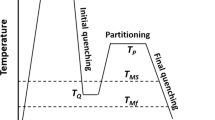Abstract
The Cu precipitation 780 MPa grade steel has higher resistance to cold cracking than the conventional steels. To study this, we have investigated the hydrogen evolution characteristics of the Cu steel heat-affected zone (HAZ) by the thermal desorption spectroscopy method and compared with those of conventional 780 MPa steel HAZ. The thermal cycle tests were conducted to obtain the HAZ microstructures, and the peak temperatures were selected from 500 to 1400 °C at intervals of 100 °C. Hydrogen was then charged, and the hydrogen evolution curves were measured at a heating rate of 100 °C/h. The results show that the amounts of hydrogen released from the specimens whose peak temperatures of the thermal cycle tests were 1000 °C or higher are lower, while the results of the conventional steels have the opposite tendency. We numerically calculated the hydrogen evolution curves to determine physical constants, and using these constants, we also calculated the hydrogen concentration profiles of the y-groove weld cracking test and found that the hydrogen concentration of the Cu steel HAZ near the fusion line tends to become lower than those of the conventional steel HAZ. This phenomenon is considered one of the reasons for the higher cold cracking resistance of the Cu steel.













Similar content being viewed by others
References
Wongpanya P, Boellinghaus T, Lothongkum G, Hoffmeister H (2009) Numerical modeling of cold cracking initiation and propagation in S 1100 QL steel root welds. Weld World 53(3/4):R34–R43
Kromm A, Kannengiesser T (2011) Characterizing phase transformations of different LTT alloys and their effect on residual stresses and cold cracking. Weld World 55(3/4):48–56
Kasuya T, Hashiba Y, Inoue H, Nose T, Itoh K, Enoki M (2012) Cold cracking susceptibility of austenitic and martensitic weld metals. Weld World 56(9/10):76–84
Kannengiesser T, Boellinghaus T (2013) Cold cracking tests—an overview of present technologies and applications. Weld World 57:3–37
Steppan E, Mente T, Boellinghaus T (2013) Numerical investigations on cold cracking avoidance in fillet welds of high-strength steels. Weld World 57:359–371
Schwedler O, Zinke M, Juttner S (2014) Determination of hydrogen input in welded joints of press-hardened 22MnB5 steel. Weld World 58:339–346
Kromm A, Dixneit J, Kannengiesser T (2014) Residual stress engineering by low transformation temperature alloys—state of the art and recent developments. Weld World 58:729–741
Bailey N, Coe F, Gooch T, Hart P, Jenkins N, Pargeter R (1973) Welding steels without hydrogen cracking. Abington Publishing and ASM International
Okamura N, Tanaka M, Okushima M, Yamaba R, Tamehiro H, Inoue H, Kasuya T, Seto A (1995) Development of copper precipitation-hardened 780 N/mm2 high-strength steel with lower preheating temperature characteristics. Nippon Steel Tech Rep 66:65–76
Kasuya T, Yurioka N (1993) Carbon equivalent and multiplying factor for hardenability of steel. Weld J Weld Res Suppl 72(6):263s–268s
Gordine J (1983) Weldability of a Ni–Cu–Cb line-pipe steel. WeldJ Weld Res Suppl 62(6):179s–185s
Irvine KJ, Pickering FB (1960) The tempering characteristics of low-carbon low-alloy steels. J Iron Steel Inst 194:137–153
Yurioka N, Nakamura H (1979) Investigation of the mass diffusion equation with activity as a variable. J Japan Weld Soc 48(9):726–730 (in Japanese)
McNabb A, Foster PK (1962) A new analysis of the diffusion of hydrogen in iron and ferritic steels. Trans Metall Soc AIME 227(3):618–627
Hirth JP (1980) Effects of hydrogen on the properties of iron and steel. Metall Trans 11A(6):861–890
Kasuya T, Hashiba Y, Inoue H, Nakamura S, Takai K (2013) Hydrogen diffusion in weld metals with retained austenite and its application to the welded joints. Weld World 57(4):581–593
Carslaw and Jaeger (1946) Conduction of heat in solids, 2nd ed. Oxford University Press, Oxford
Author information
Authors and Affiliations
Corresponding author
Additional information
IIW-2516, recommended for publication by Commission IX “Behaviour of Metals Subjected to Welding”.
Rights and permissions
About this article
Cite this article
Kasuya, T., Izawa, T., Kakeshita, T. et al. Hydrogen evolution of Cu precipitation 780 MPa grade steel HAZ with consideration of its cold cracking susceptibility. Weld World 59, 353–364 (2015). https://doi.org/10.1007/s40194-014-0204-1
Received:
Accepted:
Published:
Issue Date:
DOI: https://doi.org/10.1007/s40194-014-0204-1




